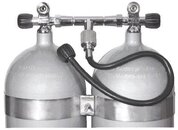Following up on Sat Diver and Bob/Grateful Diver's comments: Aside from protection, the second reason for valve-down is the way I use the isolation valve on doubles, which seems to be different than just about everyone in the US.
For me, isolation valve access must be quick, comfortable, and covenant because I open and close it 3-6 times per dive. An ex-British Navy diver first turned me on to progressive equalization. To me it makes perfect sense. You start the dive with the isolation valve shut. Once you breathe down the primary cylinder you reach back, equalize the two cylinders, and close the isolation valve again. The reserve aspect is a hallmark of most triple and quad cylinder rigs used by Cousteau and is far more effective than the early J/Reserve valves.
Each equalization can correspond with a pre-determined event based on the dive plan. For example:
1. Start meandering back toward the boat
2. Look more aggressively for the anchor
3. Stop fooling around and find the anchor
4. Forget the anchor and leave bottom right now
IMHO, the entire failure mode analysis behind the isolation manifold would be better served by leaving the isolation valve shut. If an O-ring, hose, or burst disk fails, gas is only lost from the one cylinder. You can still shut the regulator stop valve if the failure is upstream and potentially safe more gas -- especially when you can't react immediately or misdiagnose the problem on the first try.
For me, isolation valve access must be quick, comfortable, and covenant because I open and close it 3-6 times per dive. An ex-British Navy diver first turned me on to progressive equalization. To me it makes perfect sense. You start the dive with the isolation valve shut. Once you breathe down the primary cylinder you reach back, equalize the two cylinders, and close the isolation valve again. The reserve aspect is a hallmark of most triple and quad cylinder rigs used by Cousteau and is far more effective than the early J/Reserve valves.
Each equalization can correspond with a pre-determined event based on the dive plan. For example:
1. Start meandering back toward the boat
2. Look more aggressively for the anchor
3. Stop fooling around and find the anchor
4. Forget the anchor and leave bottom right now
IMHO, the entire failure mode analysis behind the isolation manifold would be better served by leaving the isolation valve shut. If an O-ring, hose, or burst disk fails, gas is only lost from the one cylinder. You can still shut the regulator stop valve if the failure is upstream and potentially safe more gas -- especially when you can't react immediately or misdiagnose the problem on the first try.






